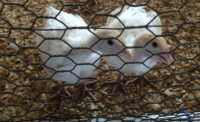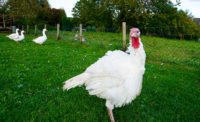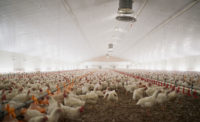Farm to Plate
Muscle myopathy and bird handling

In the 1920s, the average broiler was harvested at 16 weeks and weighed 2.5 pounds. Today, a full grow-out cycle in broiler production can be accomplished in as little as seven weeks and it’s common to have birds weighing upwards of 9 to 10 pounds by eight weeks of age. There have been remarkable transformations in recent decades for increased speed and efficiency of growth rate in animal production. With increased production rates, body weight has also increased, which has translated into increased meat production. But there may be unintended consequences associated with these changes: muscle myopathies.
The term muscle myopathy is used to describe conditions associated with muscle weakness or changes in muscle mass in meat production. Fast growth rate is one of the many factors related to muscle myopathies in a multitude of farm production species. Muscle myopathies are also associated with nutritional composition, genetic abnormalities and management practices. In poultry, myopathies are highly correlated with birds that have been selected for increased growth. Woody Breast Syndrome, white striping and deep pectoral muscle disease are examples of the most common muscle myopathies related to commercial bird production.
Woody Breast Syndrome results in a breast fillet that is hard in texture when raw and takes on a wood-like appearance. It is an emerging muscle myopathy that has been identified and characterized within the last decade.
White striping has been associated with the accumulation of white muscle striations prevalent in the pectoralis major, or breast muscle, in poultry production. Although the industry is mostly concerned with the major breast muscle, this myopathy is also observed in the thigh and breast tender of the bird. It is thought to be caused by numerous different reasons, including degeneration of the muscle tissue and several metabolic disorders associated with lipids, which are constituents of fat. This syndrome increases the fat deposition and various connective tissues in the breast meat, which ultimately results in a lower percentage of protein in the muscle. Unlike beef, in which increased fat deposition increases marbling and tenderness in prime cuts, the increased fat deposition can adversely affect poultry meat quality by causing it to become stiff and rubbery in texture. In addition, decreases in protein quantity can reduce water-holding capacity, which can decrease the quality of further-processed meat products, such as those used in lunchmeats and hot dogs.
Deep Pectoral Muscle Disease influences the supracoracoideus muscle, also known as the pectoralis minor, or breast tender, and is accompanied by a change in meat color from pink to green. This myopathy is due to a combination of conditions that manifest together to cause the muscle to become necrotic. Muscle needs space to expand, but because of the large size of the major breast muscle, the tender becomes squeezed to the point of blood flow restriction. Consequently, this restrictive blood flow reduces the oxygen content to the muscle, and ultimately results in ischemia of the muscle tissue. This causes the muscle to be replaced with fibro-adipose tissue, manifesting as a visual color change, and leads to meat texture quality issues. In addition, wing flapping, or other types of excessive exertion during handling, have been associated with an increased prevalence in Deep Pectoral Muscle Disease.
Bird handling and myopathies
Wing flapping can increase substantially during handling of birds, which may contribute to the increased prevalence of these myopathies in today’s industry, beyond any genetic predisposition of fast growth. Stress, both chronic and acute, can have an impact on the physiology of birds. Given that stress is highly integrated with several different environmental, internal and conspecific factors, it is difficult to pinpoint a solution to these myopathies. The most straightforward solution would be to genetically select for slower-growing birds or birds that have a lower market weight; however, this is not a realistic option, given the demand for poultry meat and further-processed poultry products in today’s market.
The next best solution is to improve handling techniques based on the size of the birds. Have we altered handling management for today’s larger birds as compared with the smaller 1920s version? Have we adequately accommodated the increased size and weight with regard to human safety for handling techniques of large birds to reduce strain on workers as much as reducing stress in the birds? Birds are grown at high stocking densities, which require hundreds or thousands of individual birds to be handled during load-out to the processing facility. Although there are standards for the proper catching of birds to reduce breakage of bones and excessive wing flapping, these are still problems that can happen during load-out.
The best handling techniques would be to pick birds up with their wings folded, to decrease wing flapping and ensure the breast muscles are affected as little as possible. Given the sheer number of birds that need to be loaded out in a timely manner, this is not feasible under most of the current standards in place. Nonetheless, following the best handling techniques that decrease wing flapping — and switching out handling personnel before they get tired and no longer follow the best handling procedures — may aid in reducing the prevalence of muscle myopathies observed in poultry products.
Today we live in a constantly changing commerce in which we need to continue to grow and transform as consumers’ needs change. As conditions and genetics for producing animals undergo constant alteration, we must be ready to transform with them in these fast-moving times. A lot has changed in the meat industry since the 1920s. The necessity to accommodate these changes of bird size and consumer preferences should be taken into consideration when handling these larger birds to prevent meat defects. Not only will this give the producer the best production rates, but it also will allow for great meat products to be developed and a continuous flow of goods for consumers. NP
References:
Clark, D. L. and S. G. Velleman. 2016. Spatial influence on breast muscle morphological structure, myofiber size, and gene expression associated with wooden breast myopathy in broilers. Poult. Sci. 95 (12): 2930 – 2945.
Kijowski, J., E. Kupinska, J. Stangierski, J. Tomaszewska-Gras, and T. Szablewski. 2014. Paradigm of deep pectoral myopathy in broiler chickens. World’s Poultry Science Journal. 70 (1): 125 – 138.
Kuttappan, V. A., B. M. Hargis, and C. M. Owens. 2016. White striping and woody breast myopathies in the modern poultry industry: a review. Poult. Sci. 95 (11): 2724 – 2733.
Tijare, V. V., F. L. Yang, V. A. Kuttappan, C. Z. Alvarado, C. N. Coon, and C. M. Owens. 2016. Meat quality of broiler breast fillets with white striping and woody breast muscle myopathies. Poult. Sci. 95 (9): 2167 – 2173.
Looking for a reprint of this article?
From high-res PDFs to custom plaques, order your copy today!






